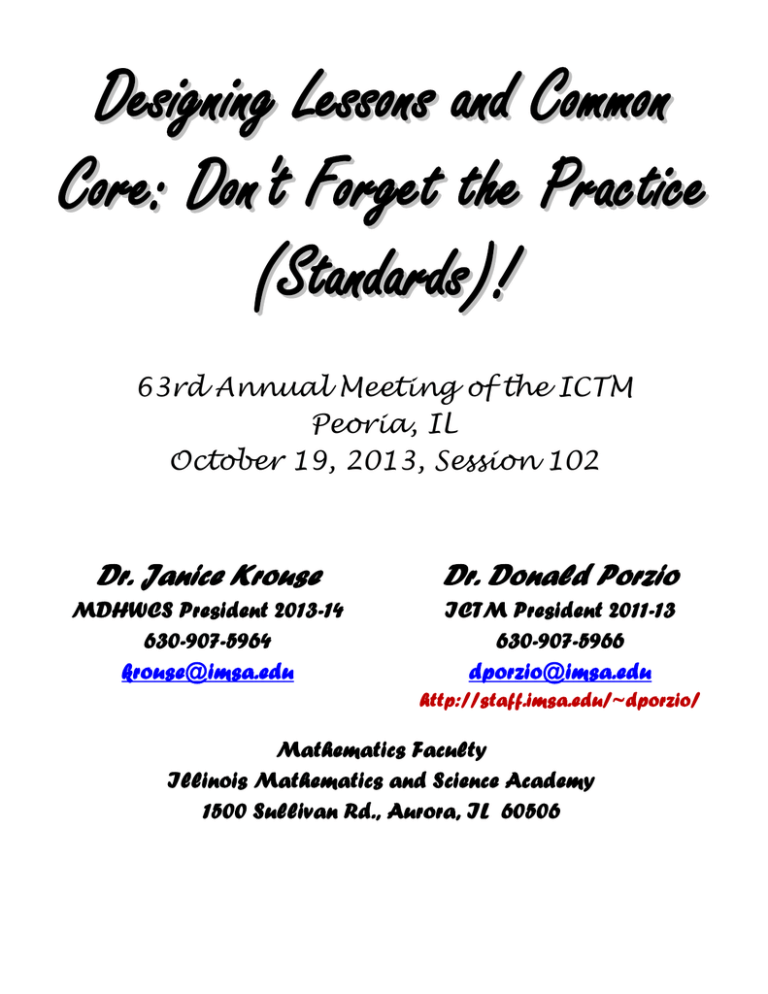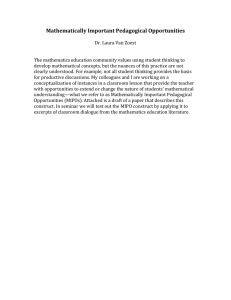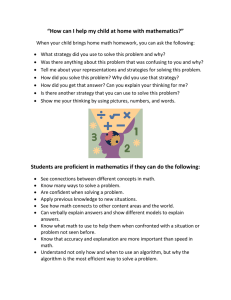Click here for 2013 ICTM Annual Meeting Material
advertisement

De s i g n i n g L e s s o n s an d C o mmo n C o r e : Do n ' t F o r g e t t he P r ac t i c e ( S t an d ar d s ) ! 63rd Annual Meeting of the ICTM Peoria, IL October 19, 2013, Session 102 Dr. Janice Krouse Dr. Donald Porzio MDHWCS President 2013-14 630-907-5964 krouse@imsa.edu ICTM President 2011-13 630-907-5966 dporzio@imsa.edu http://staff.imsa.edu/~dporzio/ Mathematics Faculty Illinois Mathematics and Science Academy 1500 Sullivan Rd., Aurora, IL 60506 3 lbs times 2 units away from lower cord equals 6. 1 lb times 4 units away from cord plus 2 lbs times 1 unit away from lower cord also equals 6, so the sides of the lower bar balance. 6 total lbs times 2 units away from upper cord equals 12. 4 lbs times 3 units away from upper cord also equals 12, so the sides of the upper bar balance. Common Core State Standards for Mathematics Standards for Mathematical Practice MP1 - Make Sense of Problems and Persevere in Solving Them Mathematically Proficient Students… Explain the meaning of a problem to themselves and seek an entry point to its solution Consider analogous problems, try special cases and simpler forms of the problem to gain insight Check answers by asking themselves “Does this make sense?” MP2 - Reason Abstractly and Quantitatively Mathematically Proficient Students… Make sense of quantities and their relationships in problem situations Decontextualize – abstract a situation, represent it symbolically and manipulate the symbols Contextualize – pause as needed during manipulation to probe referents for the symbols involved MP3 - Construct Viable Arguments and Critique the Reasoning of others Mathematically Proficient Students… Understand and use stated assumptions, definitions and previous results to construct arguments Analyze situations by breaking them into cases Justify and communicate conclusions and respond to others’ arguments MP4 - Model with Mathematics Mathematically Proficient Students… Apply mathematics to solve problems in everyday life, society and the workplace Identify important quantities in a situation and map their relationships using mathematical tools Interpret results in context of the situation and reflect on whether the results make sense MP5 - Use Appropriate Tools Strategically Mathematically Proficient Students… Are familiar with and use grade appropriate tools when solving a mathematical problem Detect possible errors by strategically using estimation or other mathematical knowledge Use technological tools to explore and deepen understanding of concepts MP6 - Attend to Precision Mathematically Proficient Students… Try to communicate precisely to others Use clear definitions in discussion and in their own reasoning Calculate accurately and efficiently MP7 - Look for and Make Use of Structure Mathematically Proficient Students… Look closely to discern a pattern or structure Are able to step back to look for an overview and/or to shift perspective Can see complex things as single objects or as a composition of multiple objects MP8 - Look for and Express regularity in Repeated Reasoning Mathematically Proficient Students… Note repetition and regularity in calculations, and look for both general methods and for shortcuts Maintain oversight of the process while attending to details Evaluate the reasonableness of their immediate results Educator Modules; © 2012, Illinois Mathematics and Science Academy Mod 1/ H 9 Standards for Mathematical Practice addressed by weight balancing problem 1. Make sense of problems and persevere in solving them. 2. Reason abstractly and quantitatively. 3. Construct viable arguments and critique the reasoning of others. 7. Look for and make use of structure. 8. Look for express regularity in repeated reasoning. Were there others? Some Content Standards addressed by weight balancing problem Are there others? Connecting the Standards for Mathematical Practice to the Standards for Mathematical Content The Standards for Mathematical Practice describe ways in which developing student practitioners of the discipline of mathematics increasingly ought to engage with the subject matter as they grow in mathematical maturity and expertise throughout the elementary, middle and high school years. Designers of curricula, assessments, and professional development should all attend to the need to connect the mathematical practices to mathematical content in mathematics instruction. SO,…. How can you design lessons that target different Practice Standards and also connect to Content Standards? The Standards for Mathematical Content are a balanced combination of procedure and understanding. Expectations that begin with the word “understand” are often especially good opportunities to connect the practices to the content. Students who lack understanding of a topic may rely on procedures too heavily. Without a flexible base from which to work, they may be less likely to consider analogous problems, represent problems coherently, justify conclusions, apply the mathematics to practical situations, use technology mindfully to work with the mathematics, explain the mathematics accurately to other students, step back for an overview, or deviate from a known procedure to find a shortcut. In short, a lack of understanding effectively prevents a student from engaging in the mathematical practices. In this respect, those content standards which set an expectation of understanding are potential “points of intersection” between the Standards for Mathematical Content and the Standards for Mathematical Practice. These points of intersection are intended to be weighted toward central and generative concepts in the school mathematics curriculum that most merit the time, resources, innovative energies, and focus necessary to qualitatively improve the curriculum, instruction, assessment, professional development, and student achievement in mathematics. Common Core State Standards for Mathematics, pg 8. Key Point in all this: Don't always let the content drive your lessons. Instead, think about the practices first, then the content! Or at the very least, think about the practices and content at the same time. You'll be pleasantly surprised as to how well the content will take care of itself when the practices are the focus and are done well. 5 5 8 4 3 1 2 1 2 6 9 8 4 1 3 9 15 7 5 4 10 2 6 10 13 3 12 7 14 11 Geometric Play The figure below consists of 20 identical squares. Divide the figure into 5 pieces, each consisting of 4 squares, so that no 2 pieces have the same shape. Note that each square in each piece must share at least one side with another square in that piece. Geometric Play The figure below consists of 20 identical squares. Divide the figure into 5 pieces, each consisting of 4 squares, so that no 2 pieces have the same shape. Note that each square in each piece must share at least one side with another square in that piece. 1 34 46 11 22 44 69 12 24 48 70 9 18 42 49 73 23 32 56 74 How Far to Zequop? The Situation: The seven towns of Tidville, Ubania, Vogton, Wimpster, Xendic, Yunjar, and Zequop are indicated on the map on the next page by the letters A to G, not necessarily in order. The roads connecting the towns run strictly north-south and east-west. The distance between adjacent dots on the map is exactly one mile. Thus, the town labeled C is 5 miles (by road) from the town E. Each town contains a sign that gives the length of the shortest route to two other towns. These seven signs, one from each town, are shown on the next page. The last sign, though, has been left incomplete. The Problem: Discover which town is where, put each sign in its correct town, and provide the correct distance to Zequop that is missing on the last sign. A F D E B C G 1 Tidville Ubania 3 4 4 Wimpster 6 Xendic 3 2 Ubania Vogton 7 3 5 Xendic Yunjar 6 3 3 Vogton 5 Wimpster 6 6 Yunjar Zequop 4 4 7 Tidville Zequop 1 ? Wimpster Sign 2 F Tidville Sign 6 E A Zequop Sign 4 A D Yunjar Sign 3 B F E Xendic Sign 7 D B C G Ubania Sign 5 C Vogton Sign 1 G 7 Tidville Zequop 1 3





